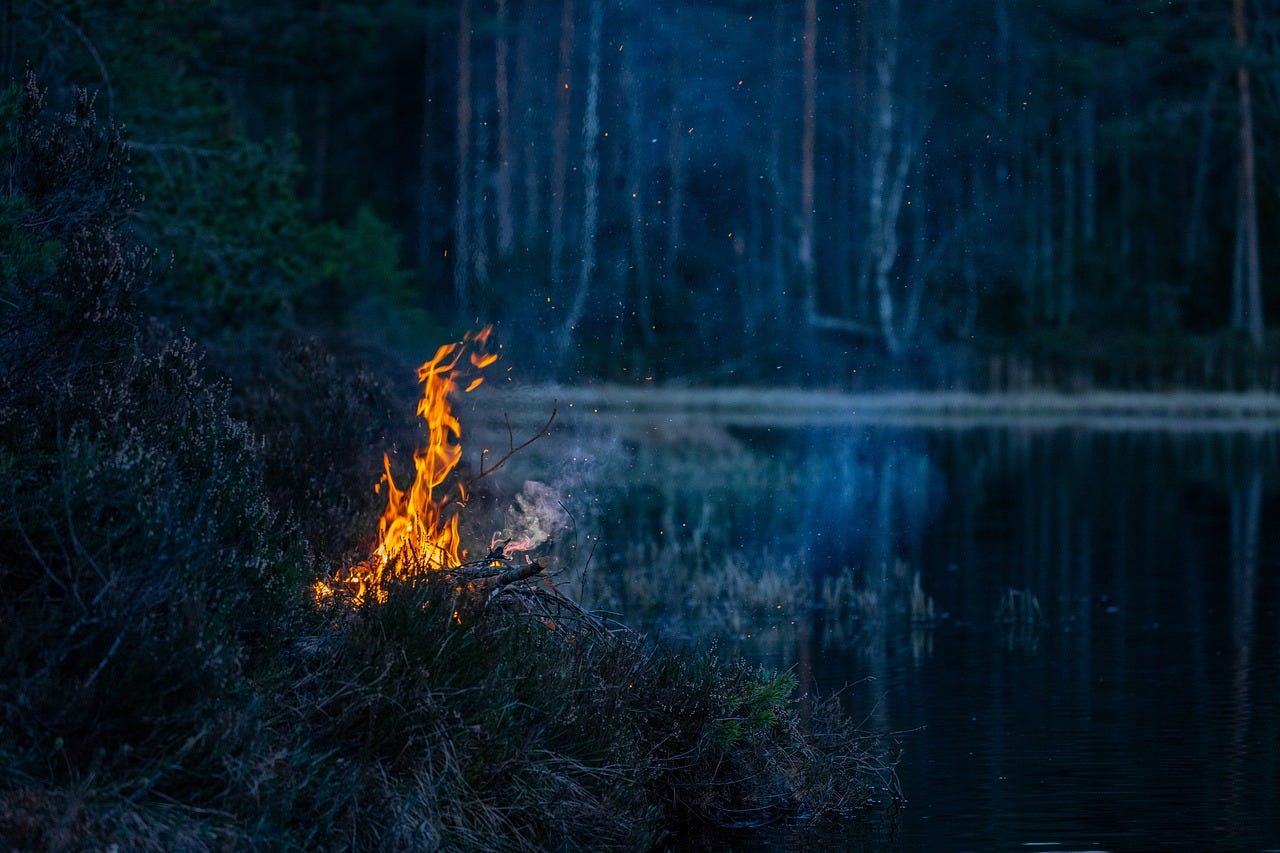“I was so angry when you left!”
Animated by quivering firelight and brooding shadows cast by the limestone walls of the Ghost Valley, a woman was sharing her experience of a wilderness vigil. Three days and nights spent in solo reflection on the land.
She had been unfamiliar with the territory and the signs and foods of grizzly bears, and so our team had accompanied her to a suitable place. But in her mind, it was the ‘wrong’ place.
“I wanted to see animals and views” she said. “And you put me in a place where I was certain I wouldn’t see anything.” To make matters worse, the only obvious sign of mammals was where somebody had made a of small pile of kindling sticks for a fire they never lit. A human! “I just sat on my backpack and fumed.” We’ve all been there. External conditions don’t match our expectations or desires. Everything would be fine if only…… things were different. And as she sat there fuming, a weasel ran over to the pile of sticks and, completely ignoring her, tore it to pieces. “I was so angry at the weasel for making such a disturbance that I shouted at it! It was scaring everything away.”
You really can’t make this stuff up. Shouting at weasels.
And then the utter absurdity of the situation descended upon her. Here she was, a woman trapped in the precarious shell of a life that she had outgrown. A pile of dead sticks. She was longing to see a magnificent predator…from a suitable distance of course. One that might signal a different kind of life. A larger, more vibrant story to which she might belong with heart and soul, with purpose and passion. But she was trapped in that moment by her mind and its limiting stories. Together they left her unable to see what was going in that moment or even to fully ‘see’ the extraordinary predator right at her feet. One who was offering a profound lesson in how to fearlessly dismantle hollow structures right there. Right here and now! In an instant, she witnessed herself from beyond herself – a perspectival expansion where she was simultaneously in the experience and beyond the experience. The moment of awareness was shattering in all the right ways.
And she wept with gratitude.
The stories we tell about ourselves are truly paradoxical for they both empower and constrain us at the same time. They illuminate the aperture through which we see the world. Our eye-dentity.
Identity is typically understood to be something that stays the same. Its etymological roots lie in the Latin word idem from whence we get identical. Mathematically, it refers to a constant that holds true across variables. Here’s a fun way to experience it:
Take your age and add the digits together. If you are 55 that would be 5 + 5 giving you 10. Now subtract that number from your age. 55 minus 10 gives you 45. Add the two digits of your new number; 5 + 4 = 9. And no matter whether you are 11 or 106, if you follow the same process until you arrive at a single digit, that number will always be 9.
The equation represents an algebraic identity where the answer remains constant regardless of the variables. It's a cool party trick and the principle is a familiar ally for mentalists, magicians and management consultants alike.
Identity also refers to the unique characteristics and properties of elements, nodes or agents that shape the relationships within a complex system or network. In some contexts, those properties remain constant. Carbon atoms share electrons with their friends to form covalent bonds with other carbon atoms. Photosynthesizing plants always head for the light. Modeling those identities helps us understand and visualize the way that local interactions lead to system-wide properties, patterns and behaviours from the bio-chemistry of your body to the Amazon rainforest. Such understanding not only invites wiser and more effective interventions. It reminds us that the pattern of relationships within any system generate its particular characteristics and ‘outcomes’; no matter how large the system, such relationships always manifest at a local scale. It’s what ‘systems change’ initiatives seek to transform, and offers a hopeful reminder to start close in.
But our personal identity is far more fluid. Some parts of the story are fixed – we don’t get to change whose DNA or ancestral histories we inherit. Others are entirely mutable – we move through stages, careers, affiliations, personas, social roles and statuses multiple times in our brief lives. We identify deeply with the moments and movements we inhabit – being a child, a leader, an able-bodied person – despite their fleeting nature. We may inflate or repress particular dimensions of our identity. And we communicate that identity through everything from our social media posts to our clothing and lifestyle choices. We signal both our belonging and our differentiation. Who we understand ourselves to be and how we want to be seen by others.
Our brand.
Whether it's a corporation or a cow, branding is a way to identify the individual amidst the herd. It’s an interesting term – to brand literally means to burn a permanent mark of ownership into the flesh of the one being branded. Our brand – the story we strategically tell about our identity – is necessarily partial and simple. That is its power. But that partiality can be something that owns us. Which brings us right back to the weasel. For our identity – who we understand ourselves to be in the moment – is often the primary barrier to the kind of learning and development that requires the expansion of perspective, the cultivation of new capabilities and thus the relinquishment or transcendence of previous fixed identities.
Who we think we are guards the doorway to who we might become!
Like baby birds, we have to find a way out of the egg in which we have gestated thus far. To crack the shell of the very thing that protects us and defines the boundaries of our world. This is true for all of us at an individual level. It’s reflected in rites of passage traditions across the human family – those wise socio-spiritual technologies that help us shed old identities so that we might move to the next stage of our developmental journey. The dying is just as important as the rebirth. Initiatory symbolism is often characterized by terrifying or devouring deities, death, blood, skulls, bones, dismemberment. The death wish that so often accompanies adolescence is familiar territory across cultures – as are its devastating consequences when it is not met by the kind of grounded ritual containers and true elders that are needed for its ripening. And beyond adolescence, it is not uncommon for us to experience a gravitational pull to the underworld whenever we find ourselves at a significant developmental threshold. It can show up in our dreamworld, in our unexpected allurements or as a strange form of carelessness about our well-being.
The deep wisdom of the psyche knows when it’s time to let go and move on.
Some days it feels like that is true for us as an entire species. Our terrifying ecological recklessness and geopolitical brinkmanship. Our apocalyptic narratives. Our eschatological socio-religious movements. Our confusing oscillation between outrage and sentimentality. Our fascination with - and vulnerability to - storytellers offering deeper meaning, purpose and belonging. Our elevation of the threshold trickster deities and the post-modern aesthetics of anti-structure. Our hunger for some sense of authenticity. Our craving for transformative, ecstatic or consciousness-shifting experiences and medicines. Our tendency to mistake what Victor Turner called the liminoid - experiences that have a liminal flavour and ritual quality but that do not result in any resolution or transformation – for the real thing.
Some days it feels like humanity as a whole is in the grip of a profound initiatory fervor but with few of the tools – the time-tested maps and disciplines, clear boundaries, generative ritual containers, wise guides and elders – offered by old-growth cultures. It’s part of why these times are so perilous and turbulent.
In many ways, the heart of our work at Wolf Willow involves learning to co-create such generative ritual containers for a certain kind of contemporary ‘change leader’ in which they can be with - listen to, discern, become more permeable to and experiment with - the edges of their own becoming. It’s a certain kind of whole-person transformative learning that invites a new level of sensitivity and open-hearted curiosity to the emergent, the adjacent possible, the uncertain and what we often call the Mystery. Bringing a quality of disciplined focus to the unravelling of our certainties and what Jennifer Garvey-Berger calls our too-small stories.
In many ways, it’s a journey of both inquiry and awakening. And we walk alongside those called to enter such a container along both the inward and outward arcs of the journey. It’s deeply personal and it precisely mirrors the very thing that complexity leaders are ‘doing’ as they support those in their world to adapt, innovate, explore, evolve, develop new capability and build a different kind of future.
Such work contains a number of polarities and variables. How do we give ourselves to the sometimes destabilizing demands of ‘depth work’ while continuing to inhabit our daily lives? How do we hold spaces that are simultaneously safe enough while offering the kind of developmental pressure needed for evolutionary growth? And how do we affirm identity – who people know and understand themselves to be – while also inviting its generative shedding? And again, all those things are as true for communities of changemakers as they are for individuals in a developmental learning crucible. Safety, dignity, agency, trust, belonging. They are non-negotiable pre-requisites – the foundational cornerstones of any ethical and effective learning journey. But they are not the primary goals of a journey of awakening.
I’m going to pivot here for a moment to the work of Christopher Wallis. Christopher is a serious scholar-practitioner who has translated a number of classical Tantric and Kashmiri Shaivist texts from the original Sanskrit. His bracing new book Near Enemies of the Truth, does much the same thing to thought-terminating spiritual clichés as the weasel did to that pile of kindling sticks. And I think he has some valuable things to say about awakening.
According to Christopher, awakening is commonly misunderstood to mean that “the awakened person knows something—or has something—the unawake person doesn’t” He argues that the opposite is in fact true: “Awakening entails losing something—specifically, your deeply conditioned beliefs about who you are and what the world is—and gaining nothing but the clarity of vision that naturally results from that loss.”
He identifies several distinct clusters of such conditioned belief from which a person might awaken; the earlier stages include our socially constructed self, our unconscious mental models through which we perceive reality, and our sense of separation from the world and others. Gradually, we begin to integrate an awakened awareness, and simply perceive reality a little more clearly.
I think he describes the journey beautifully:
We can say awakening is a paradigm shift that obliterates all your stories and ideas about reality and launches you into an indescribable mode of being in which the only true knowing is predicated upon unknowing everything you ever thought you knew. This nonconceptual experiential knowing is a kind of spontaneous immediacy in which the distinction between knowing and being collapses, resulting in raw and vivid intimacy with absolutely everything, free of the need to understand or interpret it, and free of the need to accept or reject it.
To get to where we’re going, we’ve got to stop being where we were before. It sounds simple. But it isn’t easy. We usually need a little help from a weasel or two.
And we’ll probably end up shouting at them along the way!





This has Emerald vibes…and possibly subtle nods to it. 😏